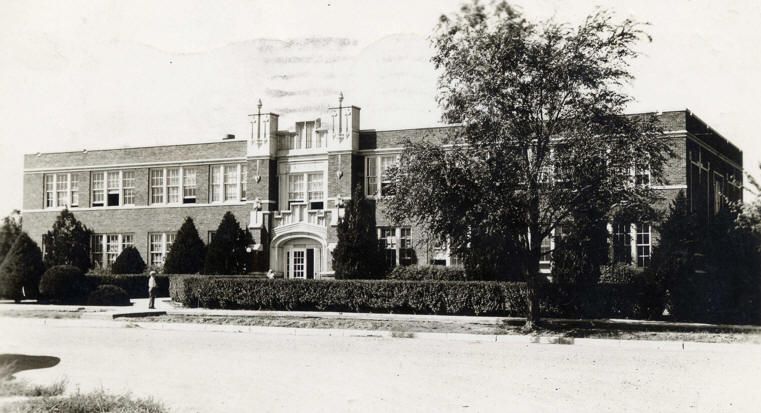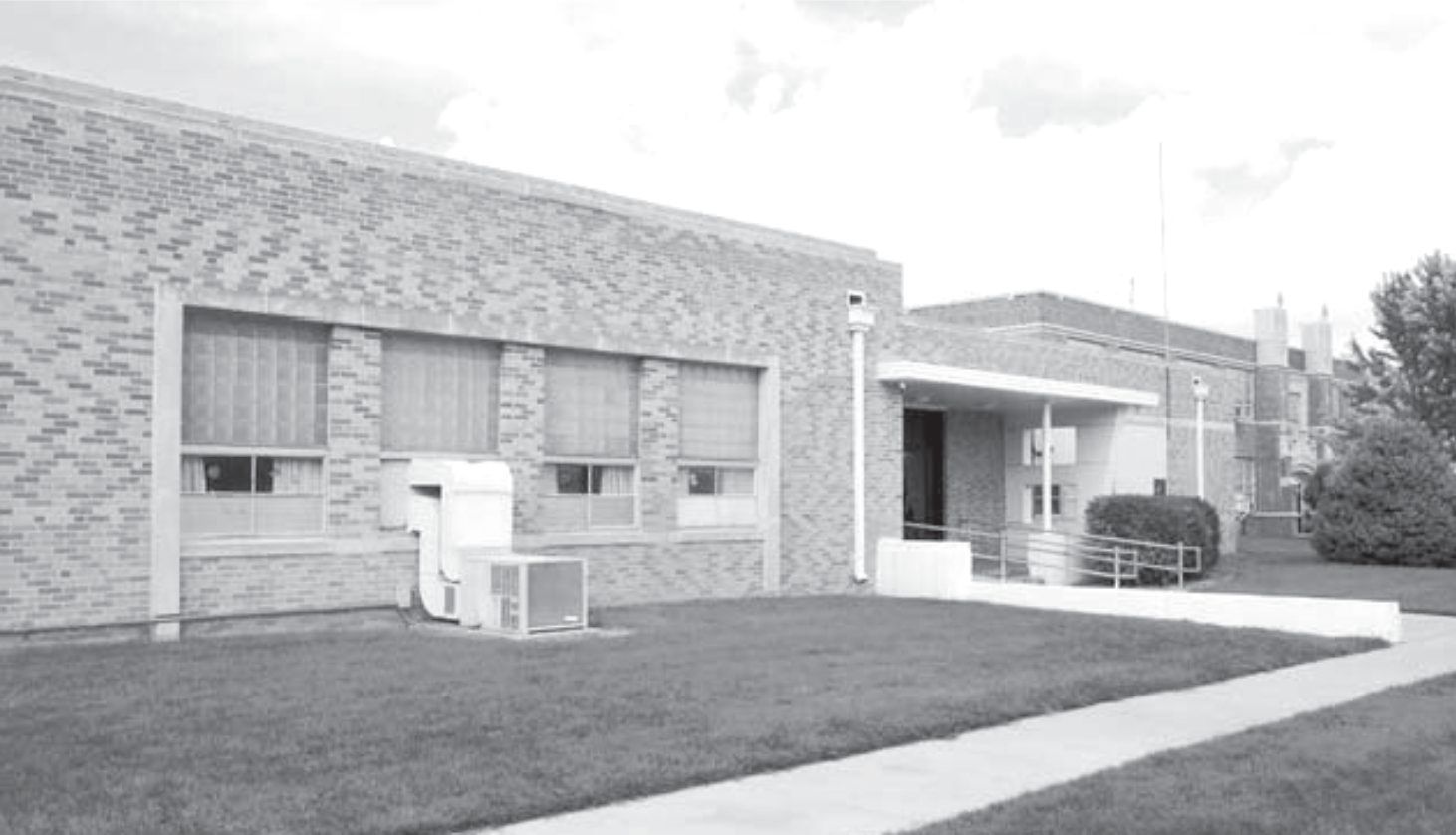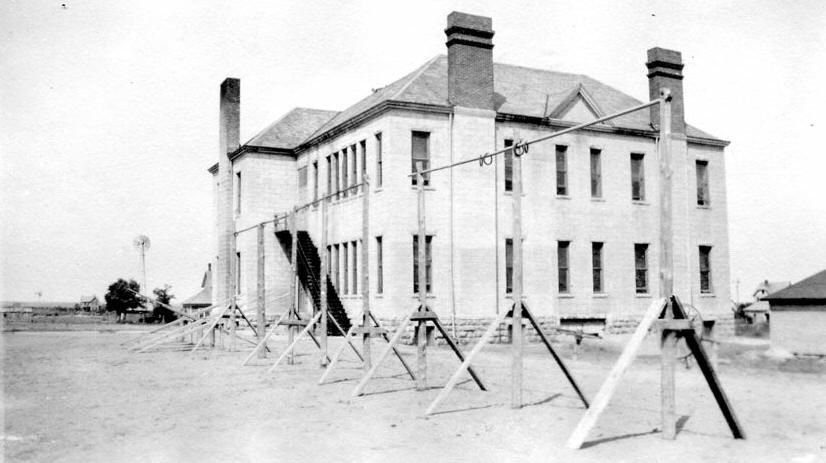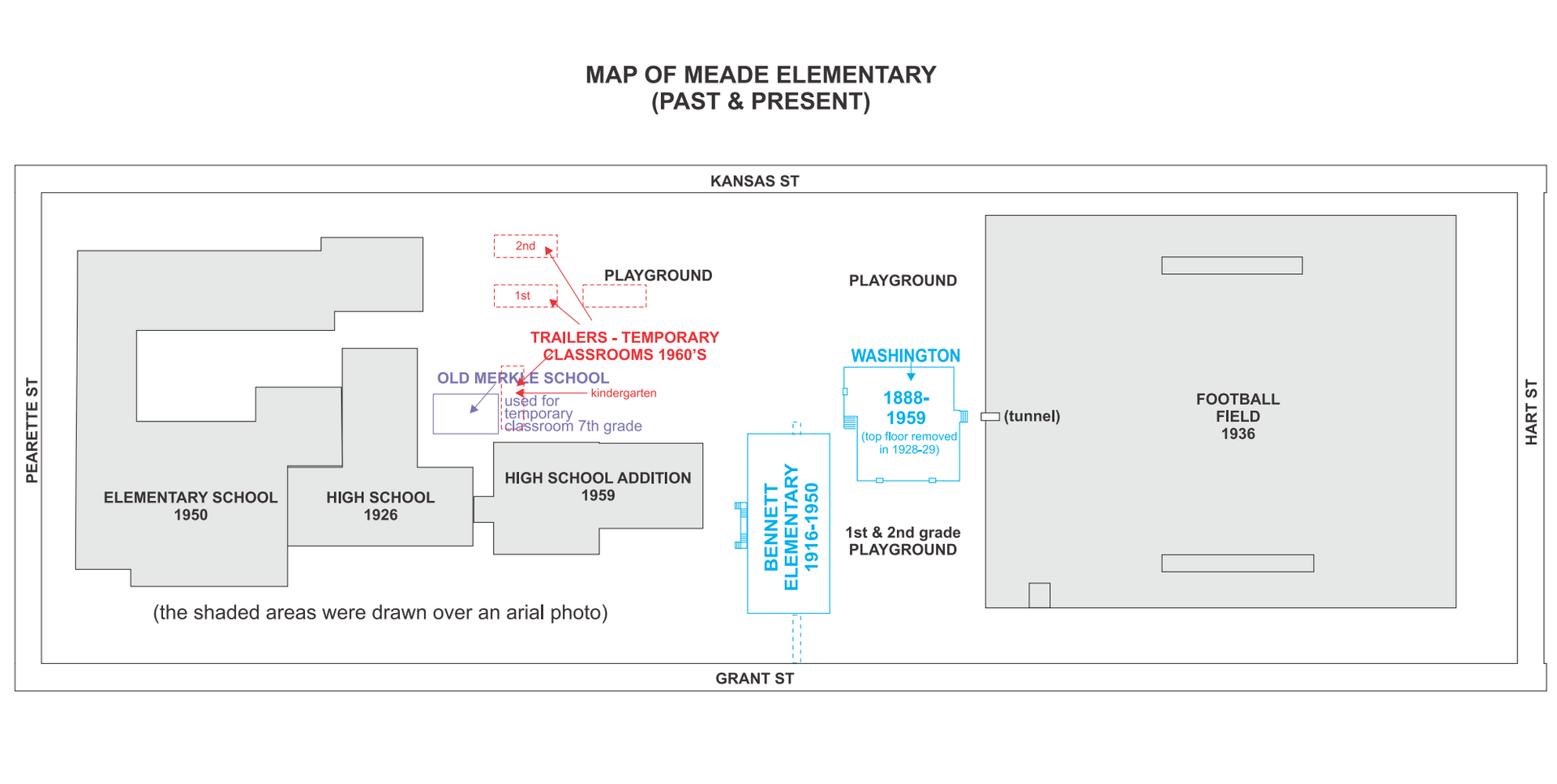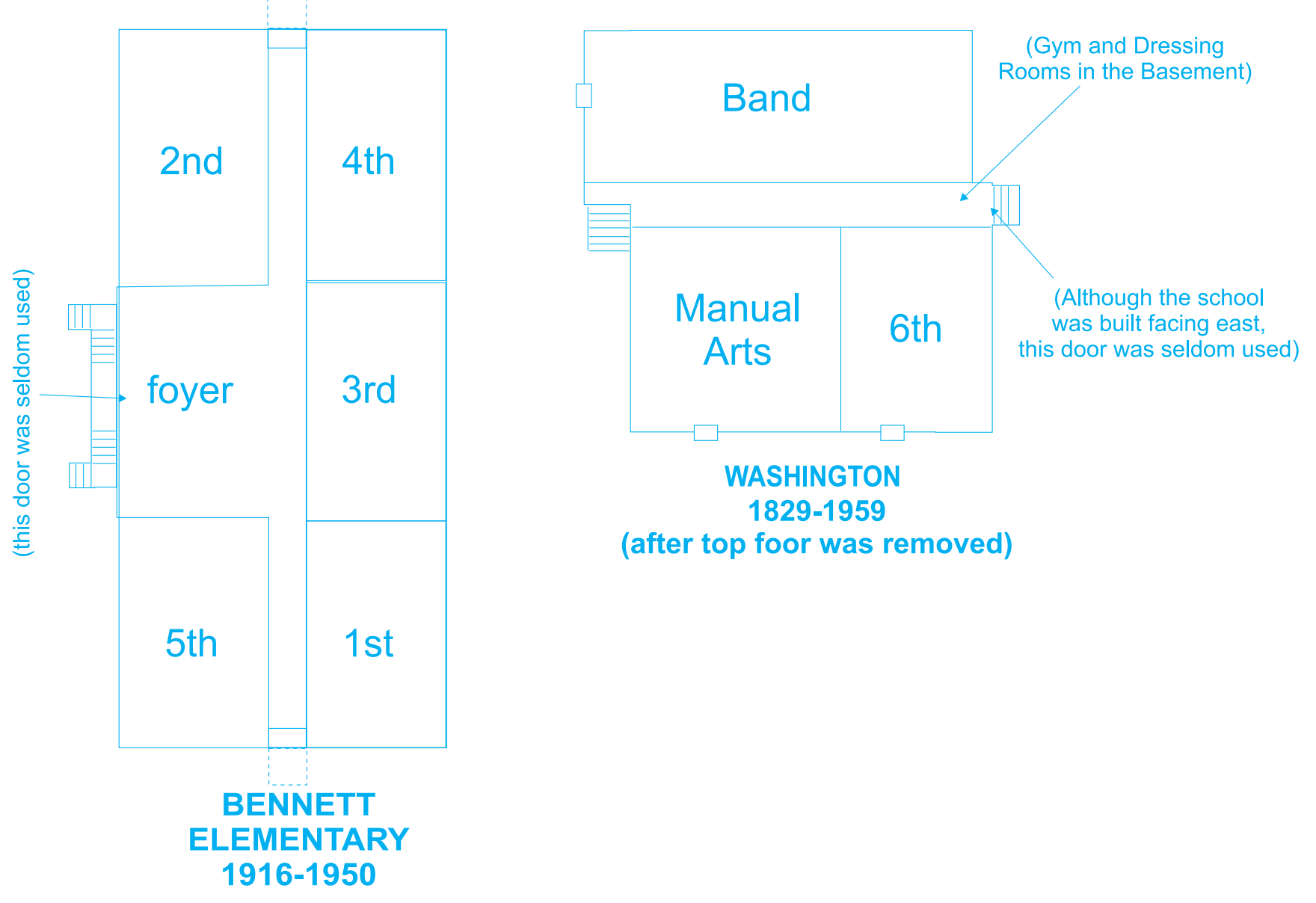Meade School System
The following history was composed in 1985, by Dave Easterday and Margaret Wilson, who had devoted thirty-four years of her life to teaching at Meade High School. Then it was brought up to date by Mr. Easterday in 1990. Hopefully someone else will grab the baton and bring it up to date from here.
Meade High School
Just three short years after Meade was established in 1885, the Washington Building was constructed just to the east of the present grade school and Jr. High. It was a two story structure containing six classrooms with a full basement. There was a bell tower with a bell large enough to be heard for two or three miles. It opened in 1888, at which time three teachers divided the sixty or so pupils into more or less ungraded groups.
It wasn't until the turn of the century that an attempt was made to form formal grades, and it was 1912, before Meade had an accredited four year high school. In 1916, the Bennett building was built to house the grade school, and in 1926, a new high school building (the current Jr. High) was erected. The upper story of the Washington building was removed and class rooms rearranged to accommodate the seventh and eighth grades and other classes.
The period from 1911 to 1916, was truly remarkable. During the summer of 1911, the (Washington) building was remodeled. More rooms were added and a heating system was installed. Then backed by a progressive school board, the young, enthusiastic, and very efficient superintendent, J.N. Hamilton, worked wonders. A school paper, the “Tattler,” was not only published but also printed semi-monthly.
A cafeteria, located in a house a block west of the school, was supervised by the domestic science teacher and staffed by students who needed to earn in order to stay in school. A high school band was organized and directed by Mr. Kelley. Vocal music was also stressed. Football had been popular since 1905. Games were played at the fairgrounds. Basketball soon became a popular sport and these games were played in the Phelps Opera House. Students had chance to meet visiting teams and rooters at skates held after the game, since the Opera House was also a skating rink. Each spring a county track meet was held in the afternoon, and a literary contest in the evening where students competed in readings, orations, and chorus.
But to students of that day, since the chance to attend high school was a privilege, class work was very important. Everyone assembled each morning for roll call and opening exercises, which included group singing, announcements, listening to classical records, and closed with a short prayer. By 1913, four courses were offered; college preparatory, normal training, business, and agriculture. A college preparatory student could enroll in four years of English, four of Latin, two of German, two of science, two and one-half of mathematics, American history, and government. A normal training student took Reviews (grammar, arithmetic, geography, and spelling), psychology and methods of teaching. “Normal” training was for students who intended to become teachers. Upon successful completion of this course, one could teach without taking the county examinations.
Superintend Hamilton resigned in 1916, and Guy Armstrong carried on successfully for the next year. Conditions became unsettled because of World War I. On account of the draft and a great wave of patriotism, the older boys dropped out to enter the service. Andrew Steele served as superintendent from 1917 to 1920. The Bennett Building, used primarily as a grade school, had been built in 1916. The basement contained a combination gymnasium-auditorium with a stage and dressing rooms at the north end. On the other sides there were two balconies, one at ground level, and the other lower. Meade's basketball teams, playing in their new gym, were outstanding, one team even made it to the state tournament in Lawrence. The older boys, returning after being discharged from the service, contributed much to the success of the football season.
Andrew Steele resigned in 1920, and for the next two years Meade High School had a difficult time. Fred Eaton the superintendent, was seriously handicapped by deafness. A number of the better teachers left, and less admirable ones had taken their places. One bright spot was the excellent job of teaching English and Latin that Marjorie Bodie continued to do.
Progress was resumed in the fall of 1922, when Ralph Smith became superintendent and Lena Martin Smith, high school principal. Beginning in 1923, a yearbook, the “Meadio,” was published every other year. Purple and white remained the school colors, and a school song was composed by Mrs. Smith. A dramatics club presented skits and one-act plays at assemblies, P.T.A. meetings, and community programs. The junior and the senior class plays were stressed. Music held a prominent place. Girl's Glee Club, Boy's Glee Club, chorus, soloists, trios, and quartets entered the music contests and received good ratings. Operettas were given, and an orchestra furnished music for school programs and for commencement. With the help of Mr. and Mrs. Smith the academic program was strengthened. Athletics continued to be important.
The highlight of his period was the completion of the new high school building in 1926. The auditorium-gymnasium was much larger, with a stage, dressing rooms, and a storage room for stage properties at the north end. A tunnel led from the main hall to a large room under the stage from which a stairway provided access. The new gymnasium gave basketball teams an excellent court on which to practice and play. Football and track continued to be practiced and played at the fairgrounds.
Then came the financial crisis of 1929, followed by the bank holiday, drought, and dust storms. The Smiths resigned in the spring of 1931. During this period with D.W. Lewis served as superintendent and Elvis Prather as high school principal, only the necessities could be afforded. The government lunch program under the very efficient management of Mrs. Effie Whitehead, was taken advantage of. Meals were served in the balcony of the Bennet Building and the cooking was done in one of the small rooms nearby. A government program (the WPA) also made possible the construction of the football field with native stone bleachers. It was located just east of the Washington Building and completed in 1936. It is said that Meade's football team started calling themselves Buffaloes at this time as a tribute to their former coach, Willis Carmichael, who was then teaching at Buffalo, Wyoming.
In the following years with M.F. Stark (1934-35) and H.D. Kemper (1935-38) as superintendents and Margaret Wilson as high school principal, a strong faculty, and a cooperative student body, progress was gradually resumed. With Myrtle Brandt in charge of vocal music, and J. Ellis Jackson of band and orchestra, music groups became outstanding. Football, basketball (both boys and girls), track, and tennis were stressed. For the girls there was Girl Reserve, and Hi-Y for the boys.
After Mr. Kemper's resignation in 1938, George Swartz became superintendent. Academic work was stressed, and Meade High School was accredited by the North Central Association. A large school bus made possible the transportation of athletic groups and of the seniors on their skip trips to Carlsbad Caverns and to scenic places of Colorado. Play days, organized by Frieda Nurse, and folk dancing made girl's gym class fun. The faculty, high school and grade, met evenings, and under the supervision of Gertrude Claytor, the home economics teacher, made a cyclorama to replace the outworn stage scenery. Then in 1940, the football season opened with a 12 to 0 win over Elkhart on Meade's brightly lighted field. A tunnel had been constructed from the west end of the football field to dressing rooms in the basement of the Washington Building.
World War II and the draft brought changes. In 1943, Superintendent Swartz joined the Navy. Orley Wilcox served as Superintendent the fall term of 1943-44, but was drafted. Kenneth Hill accepted the position and finished the spring term. This was a period of steady growth. The academic, athletic, and music programs were strengthened. Driver's training and vocational agriculture were offered. Busses provided transportation for students living in the country. Dottie Tacha accepted the position as school secretary in 1948, and served through the spring term of 1952. Then Lola Nash took over. Both girls filled a much needed place very efficiently. Kayettes, sponsored by Ruth Brumfield, and the M-Club, sponsored by Joe Urban, continued to function effectively. Future Farmers of America and an industrial arts club were organized. In 1947, the publication of a yearbook, "Buffalo Trails," was resumed.
Change came again in 1950, when the Bennett Building was tom down and a new grade building built just west of the high school and connected to it. The large gym was shared by the grade and high schools. The former gym was remodeled into an auditorium with a slanting floor and permanent seating. Also shared by both schools were the lunch room and kitchen. Mrs. Anna Wurdeman and her helpers, Georgia Hale, Anna Farley, Melva Blattner and others continued to serve very efficiently in the new roomier quarters.
In the spring of 1953, Superintendent Hill resigned to accept a better position. Margaret Wilson resigned as principal, but continued as a teacher of English and Latin. Hilton Prather became superintendent with George Highfill as high school principal from 1953-56, Lawrence Blair from 1956-58, and Dean Shoemaker from 1958-60. Football, basketball, and track continued to be stressed and were joined by tennis, which was played on courts constructed near the summer ball park. Forensics became important. Coached by Ronald Shafer, outstanding debate teams won high honors, as did play casts, extempore speakers, orators, and others. Equally successful were the various music groups directed by Waldo Wiens. Students who made the Honor Roll were recognized by becoming members of the Alpha Club. A scholarship team took part in the Emporia
Testing Program each spring. The Kayettes had long been active and continued to be. A K-Club was organized. Cheerleaders were elected by the students. Eugene Luce became superintendent in the fall of 1960, Mrs. Luce, as librarian, reorganized and beautified the library. In the fall of 1963, Bob Commons became principal and Adah Howat, school secretary since 1959, was transferred to the high school.
To any school the custodian is important. For several years Frank Byrns and later Jerry Masters and Godfrey Blehm kept the building shining. Later LeRoy Lemaster took charge of the grade school, Tom Benear of the high school, and Harold Dye of the junior high and the lawn.
In 1959, the Washington Building was torn down, and a wing containing the industrial arts, home economics department, and a large band room was added to the east end of the high school building, which marked the beginning of a period of change. After Mr. Luce resigned in 1965, Mr. Commons served as both superintendent and principal during the fall term of 1965-66. Frank Rybnick as superintendent and Mr. Commons as principal finished the year.
In the late 1960's, Mr. Rybnick and Ron Musselwhite, the new high school principal, became much concerned with the problem of overcrowding. The "baby boom" groups had reached junior and senior high schools. Then in 1967, the Meade Bible Academy, a four year high school, closed and those students came to Meade. In 1968, there were fifty-nine students in the graduating class, the largest class which has ever graduated from MHS.
It was decided to build a new high school building. This time the site chosen was a forty-five acre site at the southeast edge of town, entirely away from the original buildings.
The new school is a large one story, air conditioned brick building facing the west. In addition to the class rooms, it houses offices for the superintendent and the high school principal, a work room, a large library and a commons area. There is also an auditorium which seats seven hundred and a gym with a seating capacity of sixteen hundred.
In front of the building is a circular drive and to the south, a large blacktopped parking lot. To the east is the new football field. Bleachers were installed in 1972, and the field was used for the first time in 1973. Improvements were gradually added. A track around the field was laid in 1972-73, then in 1977, an Atlas Track (70% rubber and 30% asphalt) was installed, the first one of that type in Kansas. In 1974, the industrial arts class, supervised by Mr. James Bebermeyer, built a press box. A brick building houses the athletic equipment, a restroom and concessions. The total building, cabinets and other fixtures were built for the concession by Mr. Dwayne Hoselton's Industrial Arts class. In 1980, as a federal project, four tennis courts with wind screens were constructed a block north of the high school. Frank Rybnick served as superintendent and Ron Musselwhite as principal during the construction of and moving to the new building. In 1971, Ron Musselwhite resigned and David Easterday accepted the position of principal. Mr. Rybnick resigned in 1972, and Harold Vestal served the next three years before Dannie Clodfelter, took charge.
The athletic program evolved to consist of football, boys and girls tennis, basketball, track, and girls volleyball. The music and speech departments have continued to be active. Instead of class plays the combined music and drama classes present all-school musicals for which the stage band furnishes instrumental music.
The industrial arts department added the house project in 1975, in which the students actually help build a house which is then sold. There is also an active auto mechanics department, and a greenhouse which was built in 1979, on the northwest comer of the high school near the science room.
The old vocational building located to the east of the grade school football field was tom down in 1979, and a new metal bus barn was erected on these premises the same year.
In keeping with the times a number of new programs have been added such as a computer program started in 1982, and an audio-visual program. Meade High School also has a counselor, a special education program. Many changes have taken place, but there still remain the deep interest in education which the pioneers brought with them one hundred years ago.
Early History of Meade High School
Taken from the pages of the Meade County Historical Society 1885 History Book (copyright)
Written in 1962 by Laura S. Smith
Since records of the first schools in Meade are no longer in existence, the early part of this history is based on my own memory of the events I heard discussed as a child which had happened some years earlier, and on the memory of others who were here at that time.
The late Robert A. Brannan recalled that he was a pupil in the first school held in the town of Meade. That was in the winter of 1885 and 1886. The school was held in a store building which faced the north on Carthage Avenue, about midway between Fowler and Spring Lake Streets. Finances were by subscription, as school districts were not yet sufficiently organized to receive funds for operation. The first teacher was a Mr. Charley Edwards. Mr. Brannan also recalled the name of Melissa Louks as a teacher there. She may have been the second teacher.
Later schools were held in other buildings during the early years. A building somewhere near the intersection of West Plains and Meade Center Streets housed some of the pupils, and another on East Carthage, east of Meade Center Street, held another group. These locations are according to the memories of the late Brother Buis and William Wehrle, and of Mrs. Eva Coon, all of whom attended classes in those places. The late Mrs. M.W. (Carrie) Anschutz recalled attending classes in the Christian Church, on the site of the present Baptist Church.
About that time the district began the erection of a school building, located on the site of present Meade City school buildings. It was named the Washington School, and opened In the fall of 1888. It was a two-storey structure, containing six classrooms with a full basement, which was used for play rooms in stormy weather. There was a bell tower with a bell large enough to be heard for two or three miles.
Three teachers divided the 60 or so pupils into more or less ungraded groups. In the early 1900s, a fourth teacher was added and an attempt was made to arrange the pupils in formal grades. Some of the early-day teachers who gave splendid instruction were Tillie Turner, Jennie Kessler, Abbie Wightman (who later became Mrs. Abbie Bodle and had a long teaching career in the schools), Lou Bodle, A.T. Bodle, Ormond Hamilton, Florence Richardson, Sada Jenkins, C.P. Dawson, and Ross McCormick, to name only a few.
All through the years, a few high school subjects had been taught to older pupils. Such subjects depended upon the interest and preparation of the instructor. So early-day students had some fine ground work in such subjects as mathematics, science, Latin, German, English, and bookkeeping.
However, there came a demand for more formal high school work, and a three-year course was established in 1903. Several classes were graduated from this course.
In 1909, the school board, consisting of James Wilson, M.C. Read, and Frank Bennett, called a meeting of the highest class in the school and asked them what they planned to do the following year. The class replied that they expected to go on to school. The year of 1910 saw a repetition of the same called meeting, and the determination of the class to finish high school.
At that time, the State Superintendent W.D. Ross, and the Superintendent of the schools at Atchison, Kansas, came to Meade as an examining board to give tests and examinations to determine how well the school stood academically for accreditation as a four year high school The result was satisfactory.
In the fall of 1911, Joe N. Hamilton came to Meade as Superintendent and assistant teachers were Florence Lennen and Bertha Davis. The Washington building still housed the eight grades and the high school. It was remodeled inside to add another class room, and a science laboratory, tiny but complete, as well as a domestic science rooms in the basement. So, in 1912, the first class from a four year accredited high school was graduated.
In 1916, the Bennett building was built to house the grade school and in 1926, the new high school building was erected. The upper story of the Washington building was removed, and classrooms were rearranged to accommodate the seventh and eighth grades, and other classes. A new grade school building and gymnasium was built in 1950, the Bennett building was razed to make room for it, and in 1959 the Washington building was removed when a new wing was added to the high school.
A vocational agriculture course was added, and a suitable building was placed on land acquired for the purpose east of the school campus.
